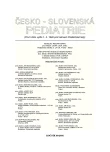-
Medical journals
- Career
Importance of Molecular Genetic Examination for Diagnostics of Wilson Disease
Authors: D. Procházková 1; P. Konečná 1; S. Vrábelová 2; L. Kozák 2; M. Dastych 3; H. Hrstková 1
Authors‘ workplace: 1. dětská interní klinika, FN Brno přednostka prof. MUDr. H. Hrstková, CSc. 1; Centrum molekulární biologie a genové terapie IHOK, FN Brno přednosta prof. MUDr. J. Vorlíček, CSc. 2; Oddělení klinické biochemie, FN Brno primář doc. MUDr. M. Dastych, CSc. 3
Published in: Čes-slov Pediat 2005; 60 (4): 188-199.
Category: Original Papers
Overview
Wilson disease (WD) is an autosomal recessive disorder of copper (Cu) transport with a frequency of 1 : 40,000 live birth. The disease is caused by a deficiency of copper-transporting ATPase – ATP7B (13q14.3-q21.1). The disorder becomes manifest as a chronic liver disease and/or neurological impairment due to accumulation of copper in several tissues, principally the liver and brain.
The most frequent manifestation of WD is between 8 and 20 years of age. The diagnosis involves determination of serum ceruloplasmine and Cu, detection of Cu in 24-hour collection of urine, carrying out a test with penicillamine, liver biopsy determining the Cu content in the hepatic dry weight and DNA diagnosis, if available. Interpretation of biochemical findings changes due to DNA analysis of mutations. As yet there is no exact correlation between the genotype and phenotype of the patient. Therapy of the disease is developing and at the present time is accepted for the hepatic from in childhood as a standard therapy with chelates and zinc. In the final stage the solution would be liver transplantation.
The group included 22 children from 5 to 17 years of age. The 1st group (12) consisted of heterozygotes for WD, siblings or offspring of patients with WD confirmed by DNA diagnosis. The 2nd group (10) were patients with hepatic form of WD, confirmed by DNA diagnosis and assessment of the copper content in hepatic dry weight. The control group consisted of 11 children aged 4 to 16 years.
In 4 probands of the 1st group, i.e. 33.3%, authors discovered that the level of ceruloplasmine in blood had decreased below 0.2 g/l (ranging between 0.12 and 0.43 g/l). They proved a statistically significant difference (P < 0.05) for CP in the serum among heterozygotes for WD; i.e. among the offspring of mothers with WD and siblings of probands with WD. Threshold levels of copper were determined in the basic collection of urine of 4 children (i.e. 0.6 μmol). The copper level in the 24-hour urine collection of 11 heterozygotes in the test with penicillamine did not exceed 12.5 μmol.
In 7 children of the 2nd group authors demonstrated a serum level of ceruloplasmine lower than 0.2 g/l, i.e. 70% (between 0.03 and 0.22 g/l). All the 24-hour urine collections for copper contained elevated residues of more than 0.6 μmol (between 0.8 and 2.67 μmol). Contrary to expectations levels higher than 1.6 μmol were detected only in 4 children. A statistically significant difference (P < 0.05) in the 24-hour excretion of copper into urine was discovered between the control group of healthy children and probands with WD, also according to the sex of the investigated individuals. In the test with penicillamine the Cu residue in urine was lower than 20 μmol (indicated as an extreme level for WD) in 8 probands. Urinary copper excretion after penicillamine administration do not contribute to the differentiation of heterozygotes and patients with WD.
An important way of screening is the determination of the copper content in hepatic dry weight. However, authors assume that interpretation of these findings will change in the near future in view of DNA diagnosis of mutations. According to these results examinations of the Kayser - Fleischer ring in early childhood hepatic forms are not very important.
In a proband with the genotype IVS12+1G>A/G1355C they discovered that the heavier the form of mutation demonstrated in a WD patient, the more severe the clinical course of the disease can be expected.
Serious mutation in the heterozygotes may mimic WD. Authors recorded an attack of anxiety disorder in a girl with the genotype H1069Q/W779X. In children with the allele H1069Q they demonstrated minimal brain damage, graphomotoric inaptitude and slightly abnormal EEG in the basic activity without a clinical correlate.Key words:
Wilson disease, genotype, phenotype
Labels
Neonatology Paediatrics General practitioner for children and adolescents
Article was published inCzech-Slovak Pediatrics

2005 Issue 4-
All articles in this issue
- The Deficiency of Immunoregulatory T Cells in Children with Diabetes Mellitus
- Importance of Molecular Genetic Examination for Diagnostics of Wilson Disease
- Evaluating the Risk of Development of Autoimmune Liver Diseases in Children after Liver Resection
- The Role of Plasma Procalcitonin and Other Inflammatory Markers as Identifiers of Bacterial Infections in Children with Solid Tumor
- Intentional Poisoning with Lethal Dose of Imipramine in a 14-year Boy
- Transplantation of Umbilical Blood in a 4-year Boy with Adrenoleukodystrophy Bound to Chromosome X
- X-linked Hypophosphatemic Rickets
- Autonomous Nervous System (ANS) and Possible Determination of ANS Activity in Obesity
- Children, Youth and Water-related Injuries
- Czech-Slovak Pediatrics
- Journal archive
- Current issue
- Online only
- About the journal
Most read in this issue- X-linked Hypophosphatemic Rickets
- The Role of Plasma Procalcitonin and Other Inflammatory Markers as Identifiers of Bacterial Infections in Children with Solid Tumor
- Intentional Poisoning with Lethal Dose of Imipramine in a 14-year Boy
- Importance of Molecular Genetic Examination for Diagnostics of Wilson Disease
Login#ADS_BOTTOM_SCRIPTS#Forgotten passwordEnter the email address that you registered with. We will send you instructions on how to set a new password.
- Career

